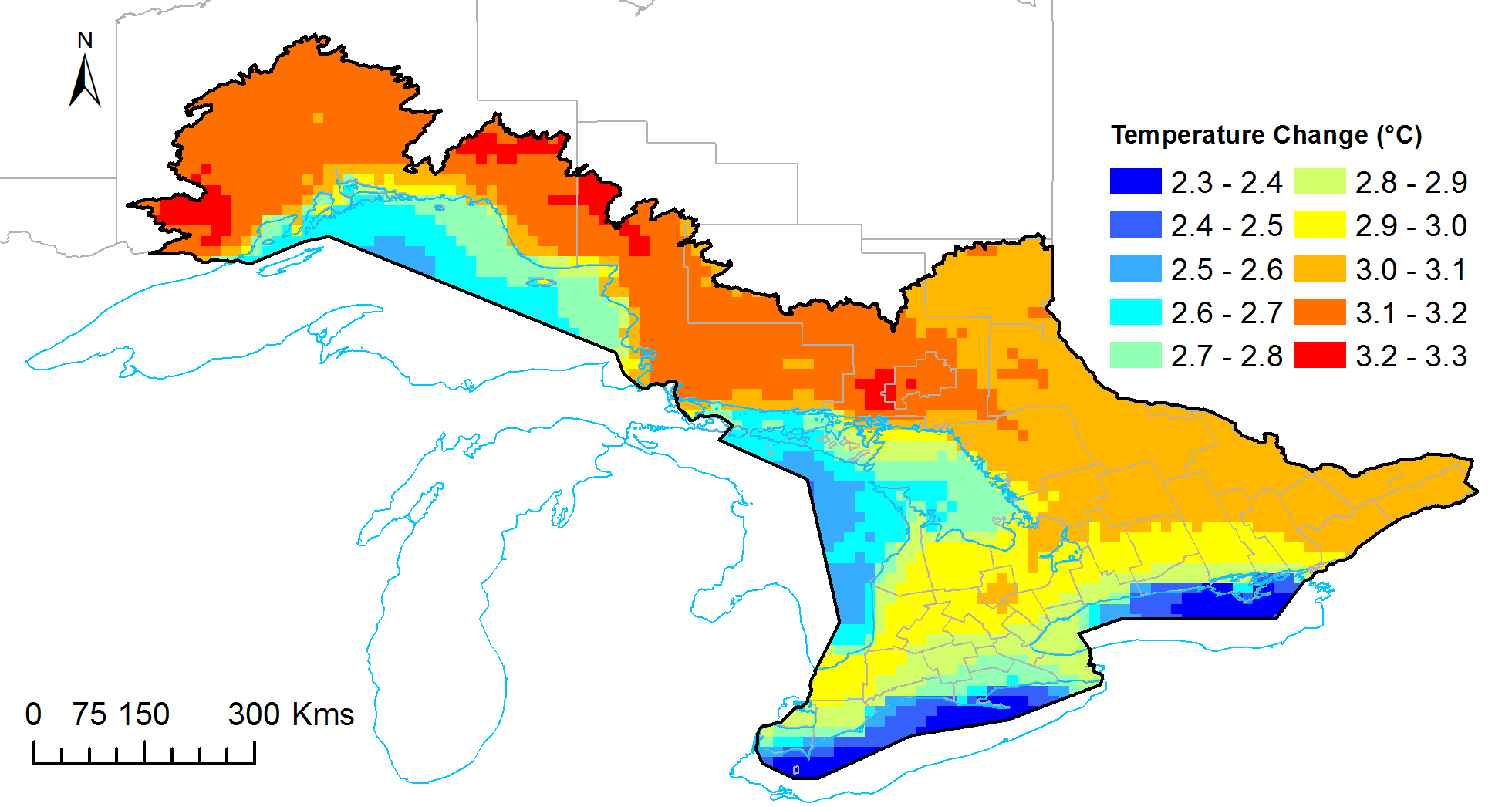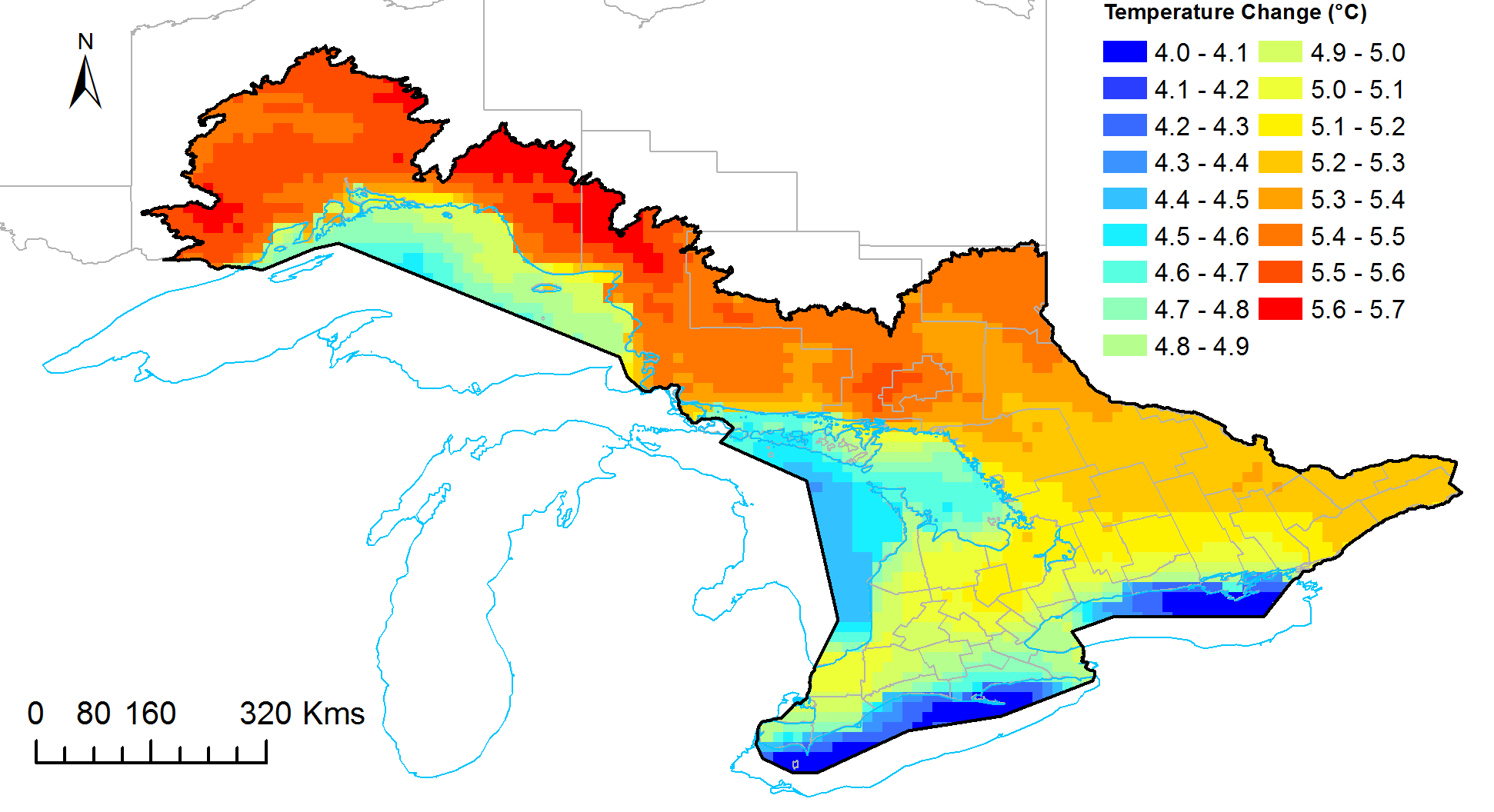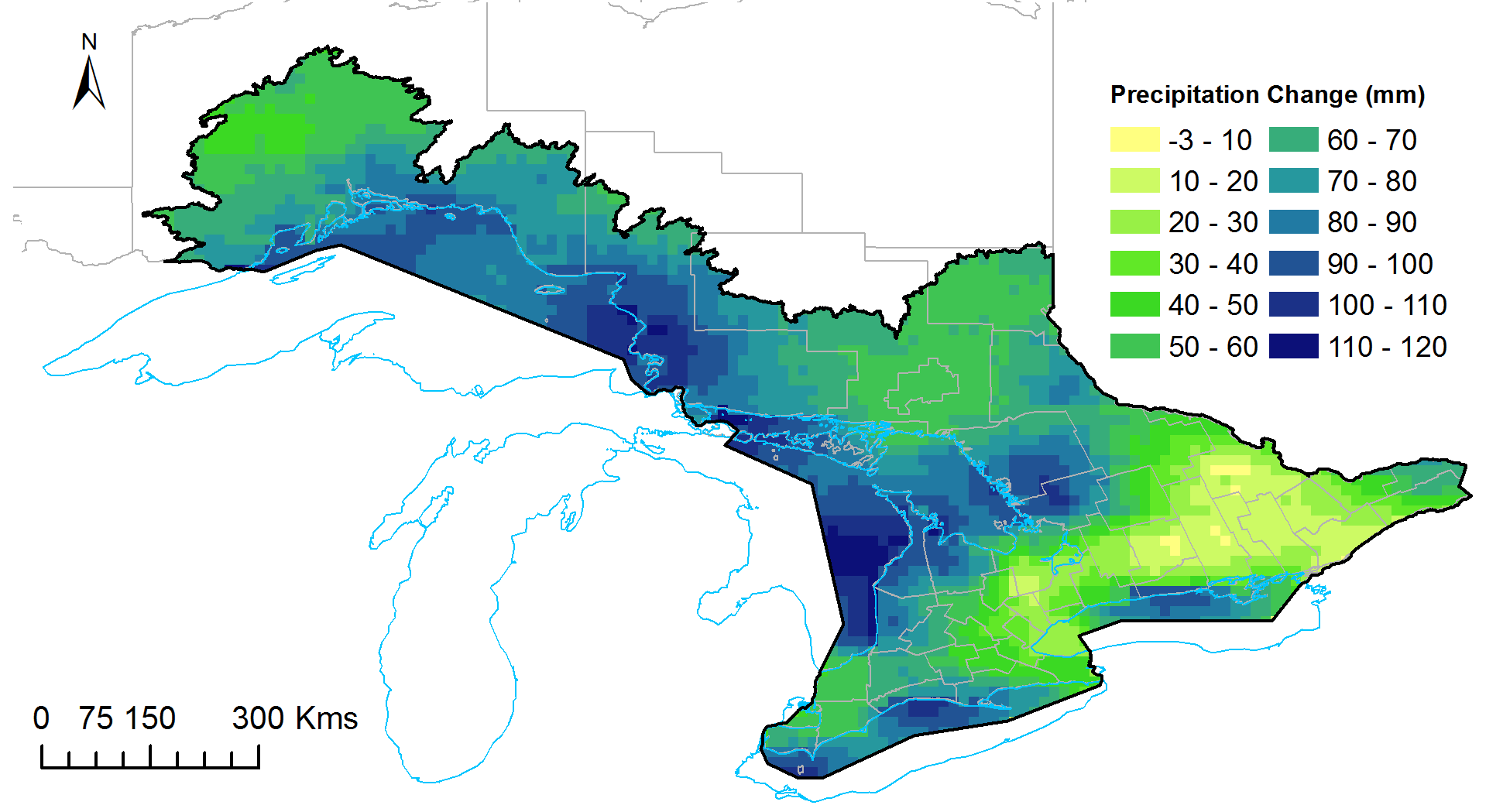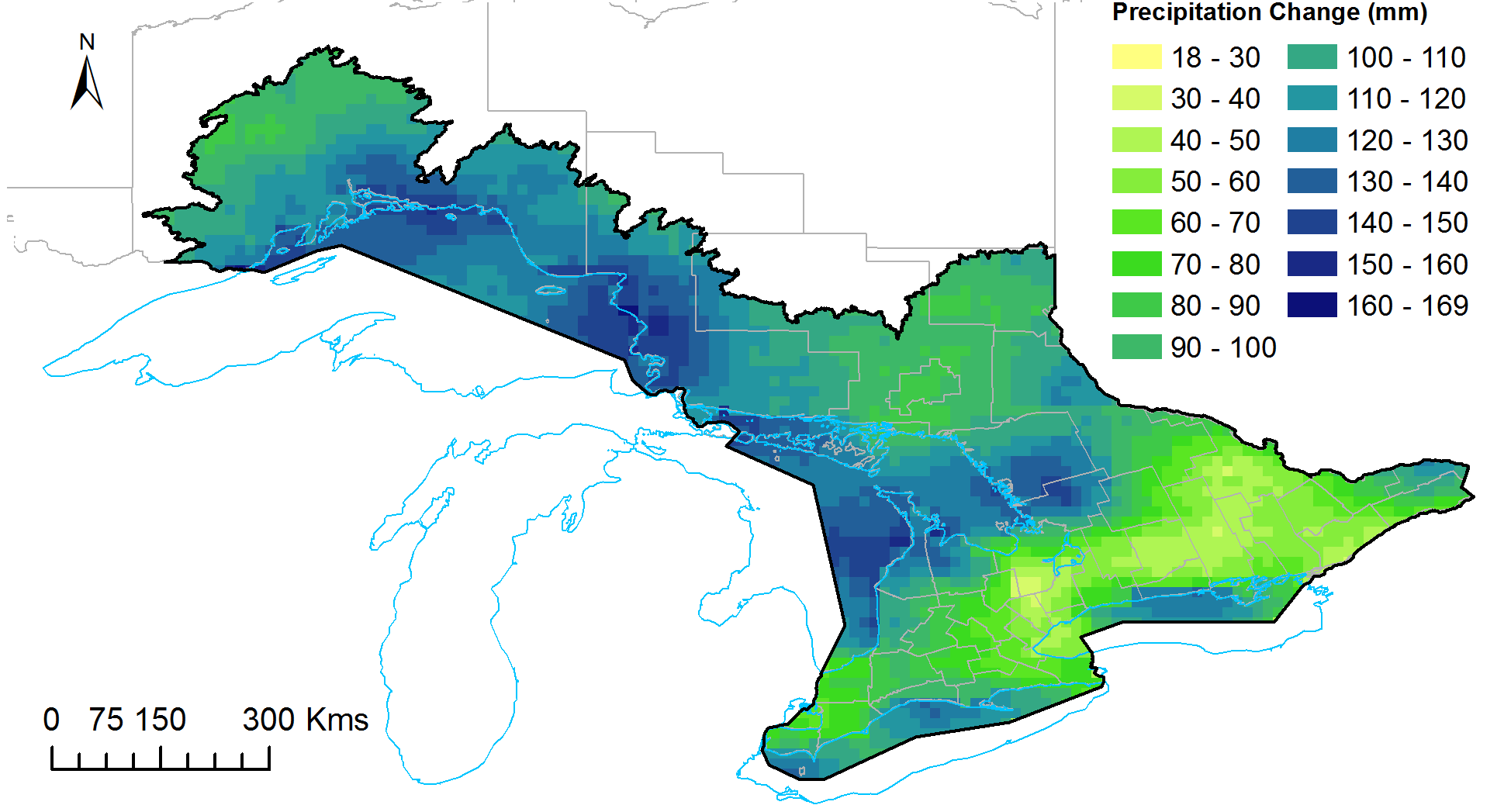Projected Temperature and Precipitation Changes over the Great Lakes Basin Based on a Super-Ensemble of High Resolution Projections
Abstract: Under the business as usual emission scenario (IPCC’s RCP 8.5), annual average air temperature over the Canadian portion of the Great Lakes Basin is expected to continue its warming trend, and could be about 5°C warmer by the 2080s (2070-2099) than the 1990s (1986-2005); annual precipitation is expected to increase by up to 22% over the Canadian portion of the Great Lakes Basin by the 2080s (2070-2099) from the 1990s (1986-2005), with greater annual precipitation projected over the Lake Superior sub-basin.
Introduction
The world's climate is warming at an unprecedented rate [1]. The global average surface temperature increased 0.85°C from 1880 to 2012 [1]. The global warming is likely to exceed 1.5°C above the 1850- 1900 average under all IPCC-defined Representative Concentration Pathways (RCPs) [1]. The warming over the Great Lakes basin is projected to be about 50% greater than the average global warming [1]. A previous study [2] based on a 32-member ensemble has revealed that, averaged warming over the entire Great Lakes Basin is projected to be 4-6°C by the end of the 21st century under RCP8.5. Another study [3] based on a four-member ensemble found that, most significant warming is projected to be in the northern portion of the Great Lakes Basin, and annual precipitation is projected to increase across all five sub-basins. Recently, a 90-member ensemble under IPCC’s RCP8.5 was developed based on both statistically and dynamically downscaled projections by credible institutes using a state-of-science downscaling methodology [4]. This report is to derive more robust projections based on this larger (90-member) ensemble to support policy makers and other practitioners for their practices in the Canadian portion of the Great Lakes Basin.
Data and Methods
- The original data are from:
- LAMPS,York University(statistically downscaled projections);
- PCIC,University of Victoria(statistically downscaled projections);
- University of Toronto (dynamically downscaled projections);
- CORDEX (dynamically downscaled projections);
- CCDP,University of Regina (dynamically downscaled projections)
- Temporal Coverage: 1981-2099
- Spatial Coverage and Resolution: Due to data availability, this analysis is only for the Canadian portion of the Great Lakes Basin, with a resolution of 0.125° (~10km).

Fig. 1 Composition of the 90-member ensemble for this study under the IPCC’s RCP 8.5
Readers are referred to [4] for details on methodology of downscaling and statistical analyses.
The authors would like to thank Shannon Fera from MNRF for providing the shape files of the Great Lakes Basin and sub-basins which are identical to those used in [3].
Results
Projected Temperature Changes by the 2050s and 2080s relative to the 1990s
The spatial distributions of the projected changes of annual average air temperature by the 2050s and 2080s (relative to the 1990s) over the Canadian portion of the Great Lakes Basin are shown in Fig. 2 and Fig. 3. For presentation clarity, different color scales are used in the plots for 2050s and 2080s.

Fig. 2 Spatial distribution of projected changes of annual average air temperature
by the 2050s (relative to the 1990s) over the Canadian portion of the Great Lakes Basin

Fig. 3 Spatial distribution of projected changes of annual average air temperature
by the 2080s (relative to the 1990s) over the Canadian portion of the Great Lakes Basin
Projected Precipitation Changes by the 2050s and 2080s relative to the 1990s
The spatial distributions of projected changes of annual total precipitation by the 2050s and 2080s (relative to the 1990s) over the Canadian portion of the Great Lakes Basin are shown in Fig 4 and Fig 5. For presentation clarity, different color scales are used in the plots for 2050s and 2080s.

Fig. 4 Spatial distribution of projected changes of annual total precipitation
by the 2050s (relative to the 1990s) over the Canadian portion of the Great Lakes Basin

Fig. 5 Spatial distribution of projected changes of annual total precipitation
by the 2080s (relative to the 1990s) over the Canadian portion of the Great Lakes Basin
Summary
Projected changes of annual average air temperature and annual total precipitation over the Canadian portion of the Great Lakes Basin by the 2050s and 2080s relative to the 1990s are estimated based on a recently developed 90-member ensemble of high resolution projections under the IPCC’s RCP8.5 (available on the Ontario Climate Data Portal). Annual average air temperature over the Canadian portion of the Great Lakes Basin is projected to be about 5°C warmer by the 2080s than the 1990s; more warming is projected over the northern portion of the Basin, with the most significant projected warming over the Lake Superior sub-basin. Precipitation is projected to increase across all five sub-basins, with the biggest increase over the Lake Superior sub-basin, by up to 169mm (~22%). The spatial pattern of change between 2050s and 2080s are similiar but with different amplitudes.
Reference
[1] Stocker, T. (Ed.). (2014). Climate change 2013: the physical science basis: Working Group I contribution to the Fifth assessment report of the Intergovernmental Panel on Climate Change. Cambridge University Press.
[2] Zhu et al. (2016). Projected changes in annual mean temperature in the 2050s and 2080s from the 1981-2010 averages for the Great Lakes Basin.
[3] McDermid, J., Fera, S., & Hogg, A. (2015). Climate change projections for Ontario: an updated synthesis for policymakers and planners. Climate Change Research Report-Ontario Ministry of Natural Resources and Forestry, (CCRR-44).
[4] Zhu et al. (2018). A Look at Ontario’s Climate of the Future with the Ontario Climate Data Portal (OCDP), Bulletin of the Canadian Meteorological and Oceanographic Society.